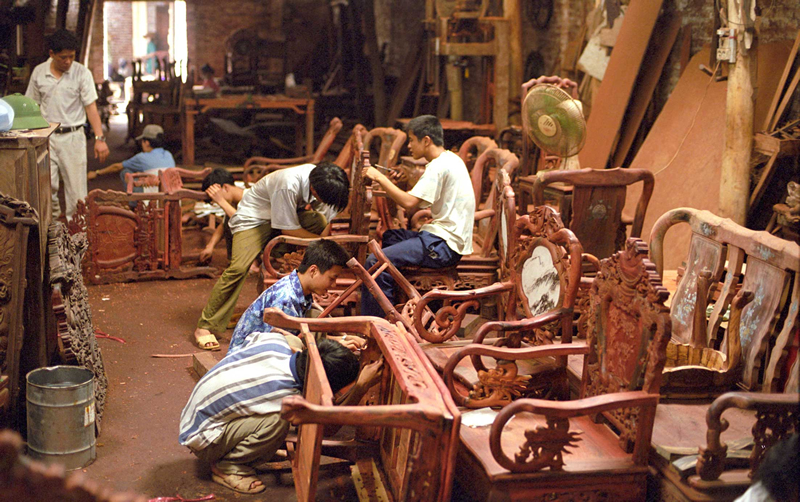This is a comprehensive guide to how to evaluate the quality of the materials from a Chinese furniture manufacturer like OPPEIN particularly when it comes to custom cabinets for kitchens, wardrobes and other furniture.
1. Understand the Types of Materials Used:
Be familiar with the different kinds of material commonly used for furniture production. For example, MDF is a medium-density woodboard. Particleboard, laminate MDF as well as solid hardwood are common materials. Each one has its particular advantages and disadvantages. Solid woods are usually the strongest and most appealing and attractive, whereas engineered materials like MDF are generally more affordable and flexible. Understanding what to look out for will allow you to compare various manufacturers.
2. Verify Certifications
It is important to look for certifications which indicate the safety and material standards. Certifications like CARB certification (California Air Resources Board), indicating the compliance of formaldehyde levels in wood, or ISO certifications for quality control in manufacturing, could indicate a commitment by a producer to create top-quality products. These certifications often assure that the materials used not contain harmful substances and that they meet international standards.
3. Evaluate the wood grades:
Ask the manufacturer about the grade. Wood is graded based on the quality of appearance, durability and intended purpose. The better grades (e.g. A or B grades) will be less prone to knots and imperfections. This leads to a more pleasing finish. Understanding the process of wood grading can help you determine the durability and quality of furniture.
4. Look at the finish of surfaces:
The quality of surface finishes will significantly impact the longevity and look of furniture. Finishes of the highest quality are smooth, even, and resistant to staining or moisture as well as scratches. Examine the texture and appearance of different finishes, and ask for samples.
5. Hardware Components to Examine
Hardware, including hinges and handles and drawer slides, is a key component of furniture's quality and performance. Check the materials and construction of the hardware. Good hardware should be solid, operate smoothly, and be resistant to wear and wear and tear. Look for brands or specifications that have a reputation for reliability.
6. Inquire About Sourcing and Sustainability:
Find out the types of materials employed by the company. Sustainable sourcing may not only benefit the environment, but also show a company's dedication to high-quality. Be sure to inquire about where the wood originates from and whether the forests are managed responsibly. Manufacturers that are committed to sustainability often have higher standards of quality to protect their image.
Review samples of products:
Request samples or prototypes of the furniture you're looking at. It allows you to examine the craftsmanship and the materials in person. Note the way they feel, weight, and are constructed. The well-constructed object should feel sturdy and solid and not show any signs of instability or weakness.
8. Inquire about Testing Procedures
Determine if the tests for materials are conducted by the manufacturer to assess durability and performance. Reliable manufactures often perform tests to test wear resistance. Understanding their testing methods will give you confidence to buy their products, as it proves their commitment to quality control.
9. Check the quality of the manufacturer's transparency:
A reliable producer must be transparent and open about the materials they use and the process they employ to make their products. They should not have a problem providing detailed information regarding the materials they use, the types they use and their methods of sourcing and any certifications. If the manufacturer is not willing to disclose this details, it could be an indication that their product is not of high quality.
10. Review the Customer Reviews and Feedback:
The final thing you need to do is look for reviews. The feedback you receive on the material, quality, overall satisfaction and many other elements could be an excellent indicator of what to expect. Pay close attention to any issues that appear in reviews such as complaints on material quality or praises for durability to get a sense of the manufacturer's overall reputation.
To conclude, assessing the quality of materials produced by a Chinese furniture maker like OPPEIN requires a thorough assessment of several factors including reviews from customers and certifications. It is possible to make a more informed decision by utilizing these suggestions and making sure the furniture you purchase is in line with your requirements. Have a look at the best best Italian kitchen brands for site recommendations including cabinet top, kitchen cabinet suppliers, white wardrobe closet, images of kitchen cupboards, new cabinets, armoire with drawers, shaker style kitchen cabinets, two tone kitchen cabinets ideas, contemporary kitchen, white armoire wardrobe closet and more.

Top 10 Tips For Assessing The Cost Competitiveness Of Chinese Furniture Manufacturers
Here's a comprehensive guide to evaluate OPPEIN's price and competitiveness, particularly if you are considering customized furniture such as kitchen cabinets and wardrobes.
1. Conduct Market Research:
Start by conducting a thorough market study to learn about the pricing environment for similar furniture products. Examine different manufacturers within the same area that are both international and domestic for a better understanding of the average prices. This will provide you with a benchmark to help you determine if the company is offering competitive prices.
2. Request for detailed quotes
Get detailed quotes from the manufacturer for the particular products you're interested in. Make sure the quotes that you receive have the breakdown of the costs of costs for materials, labor, and customization charges, in addition to shipping. Transparent quotes allow you to compare manufacturer pricing with their rivals.
3. Price versus Product Quality:
Examine the pricing of the furniture and then compare it with the quality. Sometime, prices that are lower reflect inferior quality, while higher prices may be justified by superior materials and craftsmanship. Request samples or go to showrooms to evaluate the quality.
4. Addition Costs Analysis:
Consider a purchase that goes beyond the initial price, and take into account any additional costs associated with the furniture. These costs may include shipping, customs installation, as well as service following the sale. Knowing the total cost of ownership can help you to determine the company's competitiveness.
5. Compare Customization Costs
When you order customized furniture be sure to inquire about charges. Some manufacturers charge a lot more for custom-made designs, whereas others may offer lower prices. Comparing these costs can help you find the most suitable manufacturer to meet your needs.
6. Be aware of promotions, discounts and Special Discounts, Promotions and Special
Reduce your expenses by asking the manufacturer if they offer any promotions, loyalty programs or discounts. Manufacturers offer promotional or seasonal deals to improve price competition. The savings you could make by watching out for these offers are significant.
7. Terms of Assessment Payment
Check the terms of payment offered by the manufacturer. Flexible payment terms could be a significant factor in the overall cost. For example, brands that allow staggered payments or offer financing options can offer a affordable pricing structure, particularly for larger orders. Understanding the terms involved can aid in establishing a budget.
8. Check for price match policies
Inquire whether the manufacturer has a price matching policy. Some manufacturers offer price match or beats from rivals on similar products. This is a great way to ensure that you get the best price possible without sacrificing on quality. Understanding this policy could help you in negotiations.
9. Examine the long-term value of the property:
When you are evaluating the price be sure to consider the furniture's long-term value. Take into consideration factors like the durability, warranties, as well as potential maintenance costs. The cost of the initial purchase can be justified by reality that furniture will last longer and require less maintenance. This can offer better value over the long-term.
10. You can also request other buyers' opinions.
It is also possible to ask experts and other buyers who work in the field to provide feedback about the pricing of the manufacturer. Forums, reviews websites, and social networking groups provide insight from people who have dealt with the business. They will provide you with important information regarding the manufacturer's pricing and value.
Conclusion: evaluating the price competitiveness of a Chinese furniture maker such as OPPEIN requires a thorough assessment that involves market research, detailed quotations and a review of the additional costs, and taking into account long-term value. By following these detailed steps, you can make sure that you are making a well-informed decision that will lead to a positive investment in your furniture projects. Read the top modern cabinet makers for blog examples including wooden kitchens, kitchen cabinets near, types of kitchen cupboards, wall wardrobe closet, closet cabinet, cupboard cabinet kitchen, design cabinetry, solid wood kitchen cabinets, armoire in closet, armoire and more.
